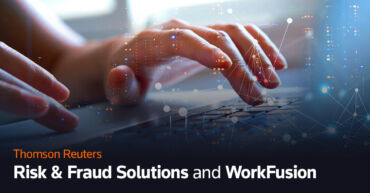With risk analysis, you can assess the risks you identified and prioritize them to ensure informed decision-making and continuity.
 |
Risk, fraud, and investigations solutions
Know today’s risk and navigate tomorrow’s challenges
|
Jump to:
| What is risk analysis? |
| Types of risk analysis |
| Approaches to risk analysis |
| Steps to the risk analysis process |
| Best practices for risk analysis |
| Final words |
One of the biggest risks nearly every organization faces is fraud. Fraud risk puts all kinds of organizations at financial risk– financial institutions, legal and tax firms, nonprofits, government benefits agencies (such as those that manage Medicaid), large corporations, and small businesses. And statistics suggest that fraud risk will only increase in the coming years.
Just about every organization is affected by today’s ever-changing economy. The rise of artificial intelligence (AI) can make fraud hard to stop. Even main-street mom-and-pops can suddenly find themselves hurt by rising interest rates, global supply chain problems, sudden changes in consumer behavior, labor market travails (such as the recent wave of strikes and near-strikes), even cyberattacks and other forms of digital fraud. Larger companies have to deal not only with these worries but others such as compliance and overseas vendors and customers that might not be who they say they are.
In other words, all organizations need to manage risk. And to do that, they need a clear picture of what those risks are and what their potential impacts might be.
That’s where risk analysis comes in. Risk analysis is a component of risk assessment, the overarching term that covers the entire process of identifying, analyzing, and evaluating risks associated with a particular project or operational activity. There are numerous possible ways that organizations can conduct risk analysis depending on their specific operations, industry, and markets. Whatever it chooses, a company needs to be rigorous in how it analyzes the risks it might face. A business’s profitability and perhaps even its survival depends upon it.
What is risk analysis?
The purpose of risk analysis is to define the level of each risk, identifying and assessing all potential threats that could result in “risk events” detrimental to key organizational initiatives or critical projects. Risk analysis prioritizes risks based on their likelihood and their potential for harm. Through a thorough assessment of these risks and an impact analysis of each, the organization can put in place measures to manage them.
Risk analysis is an essential piece to an effective risk assessment process for the overall framework of risk management. It also can provide organizations with numerous benefits that can help make them more efficient and profitable. These benefits include:
- Informed decision-making: The detailed insights that risk analysis provides enable decision-makers to make informed and proactive choices and plans.
- More effective budgeting and planning: By understanding potential risks, organizations can better allocate resources and develop contingency plans.
- Meeting compliance requirements: In many industries, risk analysis is required by the regulations that oversee those sectors. It thus helps organizations stay compliant and avoid significant legal or financial penalties.
- Organization continuity: Risk analysis helps to ensure the survival of organization operations by preparing the organization to better manage the risks it faces.
- Increased stakeholder confidence: Conducting rigorous risk analysis demonstrates that an organization has a robust risk management process. This can increase the confidence of stakeholders–including investors, customers, and employees—in the organization’s foresight and durability.
Types of risk analysis
Not every industry conducts risk analysis the same way. Each organization will adjust these types of analyses to fit its particular situation when they are identifying the different types of risks in various situations. When it comes down to preventing, detecting, and investigating risk, having more than one type of risk analysis as part of your risk management process is more beneficial than not having any. In many cases, organizations will use more than one type to get a fuller understanding of the risks they face.
Risk-benefit analysis
This is a technique nearly all organizations are familiar with. As any successful company knows, some risks are worth taking. “Enterprise risks” such as new products and markets, new technologies, and strategic acquisitions can boost top-line growth and profitability. By contrast, “operational risks” can potentially threaten a company’s operations. Risk-benefit analysis helps a company determine what category certain risks may fall into.
Business impact analysis
Conducting impact analysis can determine how disruptive the impacts of a potential risk event might be. There are numerous types of risk where this kind of analysis can be useful. Some are relatively obvious, such as supply shortages and natural disasters. Other risk events might be less apparent, including the effects of rising interest rates and the retirement of key employees with highly specialized knowledge.
Needs assessment analysis
A needs assessment analysis can reveal any gaps or deficiencies in an organization’s operations. By conducting this kind of risk analysis, the company can better determine where it needs to allocate its risk mitigation resources.
Delphi method
In using the Delphi method, an organization consults experts with deep knowledge of specific risks to predict how risky certain actions might be. The more knowledge is shared across different aspects of the organization, the more successful it will be in identifying all potential risks—and mitigating them.
Root cause analysis
The goal of this type of risk analysis is to identify existing processes that could cause disruptions to the organization in the future. An example might be a long-used software that might be out of date and thus might render a company vulnerable to a data breach or to a competitor with more effective digital tools.
Approaches to risk analysis
Once they’ve determined which type or types of risk analysis best fit their situation, companies need to choose which approach to follow for analyzing and measuring each risk: quantitative or qualitative.
Quantitative and qualitative risk assessment approaches are both important for a comprehensive analysis of risks because they offer different perspectives and insights into the potential impact of risks on a project, business, or any other organizational process.
Quantitative approaches
These approaches use mathematical models and statistical methods to assess risk. They’re particularly useful for analyzing risks in large, complex systems and determining their likelihood and potential severity. Since quantitative approaches are based on numerical data and modeling, they can provide an objective analysis of risks and possible risk events.
Monte Carlo simulation
What are all the possible results of a proposed organization’s decision or action? That’s what a Monte Carlo simulation can help identify. Put very simply, this approach seeks to simplify these forecasts by taking all the variables or risks involved in the decision or action and translating them into numerical values. That way, an organization can understand how likely or unlikely each outcome might be. For instance, a manufacturer could estimate the possibility of cost overruns due to supply-chain problems, evaluating the risk impacts of product-component shortages.
Scenario analysis
Scenario risk analysis involves creating hypothetical scenarios that could potentially occur and then assessing the risks and costs associated with each scenario. This can help all stakeholders identify potential vulnerabilities and prepare contingency plans for risk mitigation resources.
Decision tree
This approach has similarities to Monte Carlo simulation in that it identifies all the possible risks and results of an organization’s decision or strategy. It resembles a risk assessment matrix in that it assigns a number value to each result based on the likelihood and impact of that result. A decision tree depicts a choice a company could make regarding its operations–and what that choice’s potential risk might be.
Qualitative approaches
Qualitative risk analysis uses subjective approaches to risk identification based on probability and impact analysis. Instead of using numbers and other quantitative metrics, qualitative analysis focuses on less measurable factors that can affect the likelihood of a risk event occurring. These can include emotion-based decision-making, hunches, and differences of opinion and motivation among company leaders, employees, investors, and the public, and how these factors could result in disruptive risk events. It thus can identify and assess risks that quantitative approaches might overlook.
Risk narrative
This approach analyzes risk based on subjective or “narrative” evidence, such as expert opinion and the experience of company leaders and key employees. This method can be useful when quantitative data isn’t available or when a company wants to assess risks associated with new or untested technologies, vendors, and customers.
Risk assessment matrix
A risk assessment matrix is a visual tool for evaluating and prioritizing potential risks. A typical risk matrix is laid out on two axes, with the likelihood of a risk event plotted on one axis and the severity of the risk impact on the other. Each cell in the matrix represents a specific risk scenario and is assigned a corresponding risk level based on the intersection of the likelihood and severity.
Ordering techniques
These are qualitative approaches to organizing risks—determining how likely they are to become risk events, and how disruptive an impact those events might have on the organization. They include:
- Ranking, which assigns “weights” (heavy to light) to risks based on how likely they are to be disruptive.
- Rating, which assigns all risks to company-designated categories of “high,” “medium,” and “low.”
- Screening, which uses an evidence-based approach to determine which risks need to be addressed first.
Bowtie method
Bowtie representations depict the flow of organization processes and their potential consequences. They can help enterprises identify where risks might “creep in” to a process. Companies then can determine how they can prevent identified risks from disrupting their operations.
 |
Risk & Compliance ReportA delicate balance between risk and reward
|
Steps to the risk analysis process
In general, an effective risk analysis process follows the following steps:
Identifying risks
Before an organization begins the risk analysis process, it must focus on the overall risk management process by seeking possible risks in different situations. This involves identifying those risks that could turn into risk events that could affect the organization’s ability to achieve its objectives. These impacts can be either beneficial or harmful to the company’s future. Understanding the different types of risks can help an organization understand what type(s) of risk analysis they will need to perform.
Analyzing a risk’s impact
This is where the risk analysis process begins and ends. Impact analysis is perhaps the biggest component of the risk analysis process. It requires that the company determine the impact of a potential risk event through either quantitative or qualitative methods—often both.
As stated before, quantitative and qualitative risk assessment approaches are both important for a comprehensive analysis of risks because they offer different perspectives and insights into the potential impact of risks on a project, business, or any other organizational process.
Qualitative risk assessment involves a subjective analysis of the potential risks based on the experience, expertise, and judgment of the assessors. This approach is useful for identifying risks, prioritizing them, and deciding which risks need more detailed analysis. It often involves categorizing risks into different levels (e.g., high, medium, low) based on their perceived severity and likelihood of occurrence. Qualitative methods are particularly helpful when precise data is scarce or when assessing complex scenarios that do not lend themselves to easy quantification.
Quantitative risk assessment, on the other hand, involves numerical analysis to estimate the probability and impact of risks. This method often uses tools and models such as Monte Carlo simulations, sensitivity analysis, scenario analysis, expected value calculations and many others. The benefit of quantitative analysis is that it provides a more objective basis for understanding risks, which can be especially valuable when making financial decisions or when you need to compare different risks or risk mitigation strategies on a common scale.
Both approaches have their limitations. Qualitative assessments can be biased by the assessors’ perspectives, while quantitative assessments rely on the quality and availability of data, which can sometimes be limited or inaccurate. Therefore, using both approaches together provides a more robust risk assessment, allowing decision-makers to understand both the nuanced, subjective aspects of risk as well as the more precise, data-driven aspects. This can lead to better risk management and more informed decision-making.
Prioritizing the risks
At this point, risk analysis essentially ends. An organization’s risk assessment process continues by prioritizing which risks need to be addressed first—and promptly. This could be based on impact, frequency, time to set up, customer fears, costs, and other scores.
Creating an action plan
Once the risks are identified and prioritized, the organization uses what it has learned and creates ways to eliminate or reduce the impact of a risk. It also will need to look at the costs of these control measures to determine whether they exceed the value of risk mitigation. In some cases, an organization may decide that responding to a risk event after it occurs is more cost-effective than preventing it from occurring.
While these steps are standard in all risk analysis efforts, there are many methods and strategies organizations can use when following these steps. So, although it may take time and money to create an effective risk management framework, your organization will be better with it in the long term.
Best practices for risk analysis
When it comes to risk analysis and ensuring that a good job has been done before moving on to prioritizing risks, best practices generally include the following steps:
- Comprehensive Risk Identification: Make sure that the risk identification step was thorough and inclusive of all possible risks. Use a variety of methods and sources to identify risks, including brainstorming with a diverse group of stakeholders, reviewing historical data, and considering industry-specific risk factors.
- Data Verification: Check the data and information used in the quantitative analysis for accuracy and relevance. Ensure that the data and any analysis tools are up-to-date and reflect the current situation. Using AI can help also safeguard your organization.
- Methodology Check: Review the methodologies used for both qualitative and quantitative analyses to ensure they are appropriate for the context and that they have been correctly applied. This includes the models, assumptions, and parameters used in the analysis.
- Assessment of Assumptions: All risk analyses are based on certain assumptions. It’s important to explicitly state these assumptions and assess their validity. Consider how changes to these assumptions might affect the analysis.
- Peer Review: Have the risk analysis reviewed by another party, such as a peer group or an external consultant. This can help identify any biases or errors in the analysis and provide an additional level of scrutiny.
- Validation Against Objectives: Ensure that the risks being analyzed are evaluated in the context of the organization’s objectives. Risks should be relevant to the strategic, operational, financial, and compliance objectives of the organization.
- Stakeholder Feedback: Engage with stakeholders to gather feedback on the risk analysis. Stakeholders may offer insights or perspectives that were not considered in the initial analysis.
- Documentation and Transparency: Document the risk analysis process, including how risks were identified, analyzed, and evaluated. This transparency helps build confidence in the analysis and provides a record for future reference.
- Actionable Outputs: Ensure that the analysis produces actionable outputs. This means that the results of the analysis should be clear and understandable to those who need to act on them, providing a solid foundation for the risk prioritization process.
- Review and Update: Risk analysis is not a one-time activity. Regularly review and update your risk assessment to account for new risks and changes in existing risks.
Final words
Regardless of the types and techniques a company chooses, risk analysis is an essential practice for all types of organizations. Which approaches a company takes will vary based on its industry, size, competitive landscape, market, and other organizational considerations.
To make its risk analysis efforts as effective as possible, companies should also consider integrating digital risk assessment tools into their processes. Such tools, if carefully vetted and chosen, can help an organization be more accurate and efficient throughout every aspect of risk assessment, including risk identification, risk management, and risk mitigation. In an increasingly complicated organization environment, companies need these kinds of tools to manage the complexity of the risks they must address.
 |
Risk management: The framework
Navigate the dynamic landscape, covering steps for effective resilience
|










